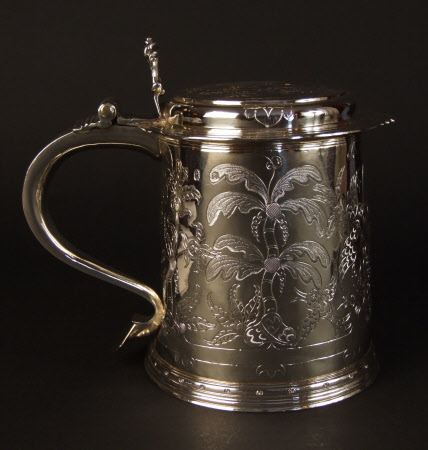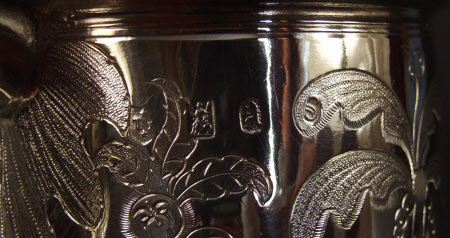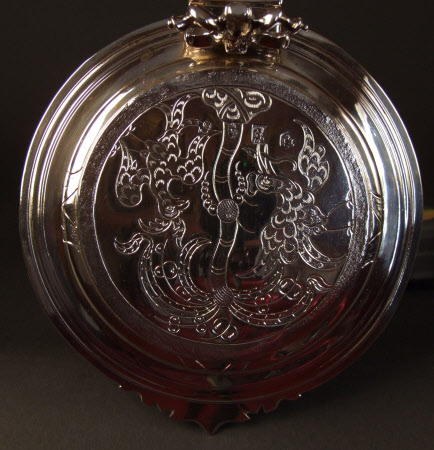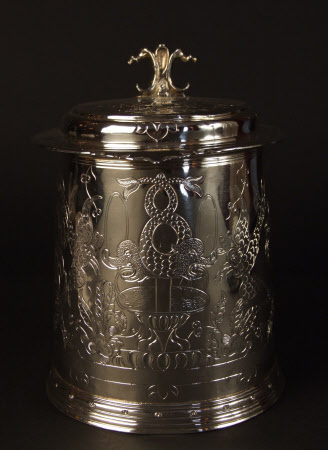Tankard
Robert Timbrell
Category
Silver
Date
1699 - 1700
Materials
silver
Measurements
205 mm (H)146 mm (W)220 mm (D)30 oz t (Weight)
Place of origin
London
Order this imageCollection
Polesden Lacey, Surrey
NT 1246837
Summary
Tankard, Britannia silver, by Robert Timbrell, London, 1699/1700. The tapering cylindrical body is raised and has applied mouldings at the lip and at the base to form a foot ring. The S-scroll and D-section handle is also raised and consists of a flat face contoured to the scroll and soldered to a rounded inner portion, the lower end being closed by an applied shield-shaped plate. The raised lid is double stepped with a flat top and has a broad, applied rim decorated with engraved concentric lines and serrated and pointed to the front. There is a cast, double-corkscrew thumbpiece and the cover is connected to the handle by a five-part pin hinge. The body and cover have chased east and south Asian inspired decoration in the style now known as chinoiserie. This is almost certainly a late 19th or early 20th century addition. It is comprised of birds, palm-like fruiting or flowering trees and, opposite the handle, a dolphin fountain. Hallmarks: the tankard is fully marked below the rim with maker’s mark ‘Ti’ between two mullets (above and below) in a shield shaped stamp for Robert Timbrell (fl. 1686-1716) [1], Britannia, leopard’s head erased for London and date letter ‘d’ for 1699/1700. NOTE: [1] Arthur Grimwade, London Goldsmiths 1697-1837, 1990, no. 2810 and The National Archives, PROB 11/555/134, will proved 1 December 1716.
Full description
This tankard is of the standard form for the last quarter of the 17th century. The chinoiserie decoration is a heavy-handed, unrubbed copy of that on another of the Polesden tankards, that of 1678/9 probably by John Sutton (NT 1246838). As it also falls outside the normal date-range of chinoiserie decoration and there are no other known examples associated with this maker’s mark there is little doubt that it is a late 19th or early 20th century addition intended to deceive. The tankard forms part of the substantial and important collection of late Stuart silver assembled in the first three decades of the 20th century by Dame Margaret Greville (1863-1942) for her London house, 16 Charles Street, Berkeley Square, and now preserved at Polesden Lacey.[1] 16 Charles Street had an enormous dining room and it was there that the Stuart silver would have been displayed at the glittering assemblies of political and society figures gathered for lunches and dinners. In 1930 the Daily Telegraph recorded, in an account of her entertaining, that ‘silver tankards, cups, goblets, and bowls, were placed on the tables - Mrs. Greville is very proud of her rare silver’ and in 1933 the News Chronicle noted, albeit incorrectly with regard to period, that the dining table was ‘laden with Georgian silver’.[2] As with other elements of her collecting, Mrs Greville acquired pieces of silver that would impress through their quality and desirability individually but that could also form part of symmetrical arrangements. In the case of tankards she eventually had eight at her disposal. No details survive of how Mrs Greville acquired the tankard but it is likely that she did so, as with her pictures, through a dealer who perhaps sourced all her silver.[3] James Rothwell, National Curator, Decorative Arts June, 2022 NOTES [1] National Trust archive, Polesden Lacey, Probate inventory following the death of Dame Margaret Greville, 1942. [2] The Daily Telegraph, 19 November 1930. [3] A candidate is Lionel Crichton of Crichton Brothers, whose business was founded in 1889 and who advised the 10th Earl of Stamford on his silver purchases between the World Wars. For Lord Stamford’s patronage see James Rothwell, ‘ ‘A Plethora of Plates’: The re-assembly of the Warrington silver at Dunham Massey, Cheshire’, Apollo, April 2001, pp. 30-34.
Provenance
Acquired by Dame Margaret Greville (Margaret McEwan, the Hon. Mrs Ronald Greville) (1863-1942); recorded as having been at 16 Charles Street, Berkeley Square in the 1943 probate valuation following Mrs Greville’s death; bequeathed with Polesden Lacey to the National Trust in memory of Mrs Greville’s father, William McEwan (1827-1913).
Credit line
Polesden Lacey, the Greville Collection (National Trust)
Marks and inscriptions
32489 (engraved on base)
Makers and roles
Robert Timbrell, goldsmith



